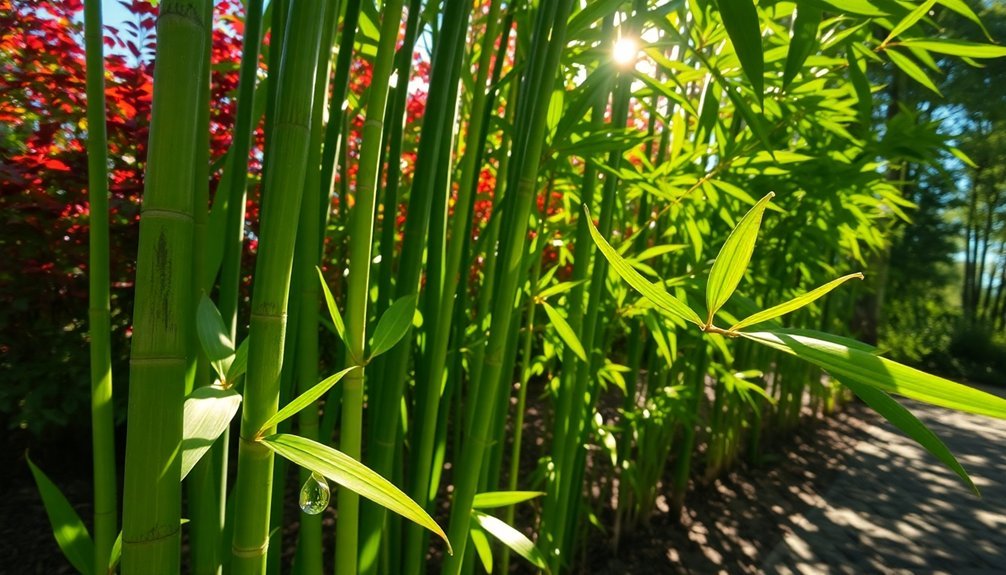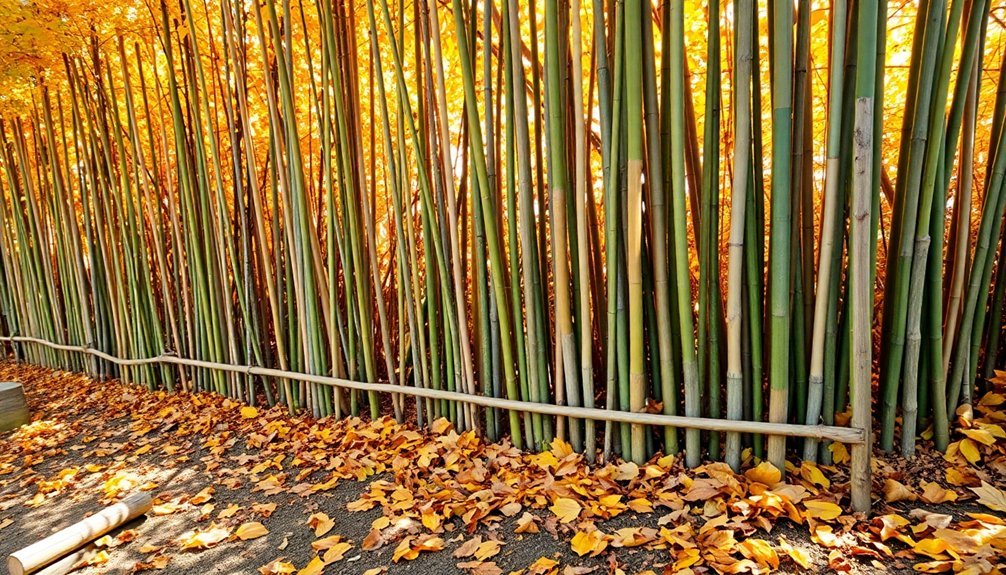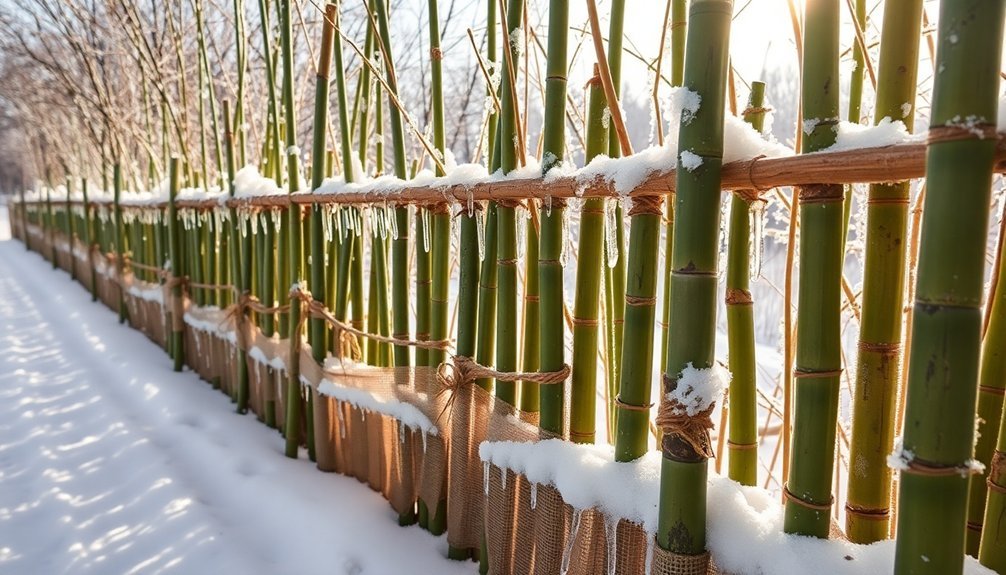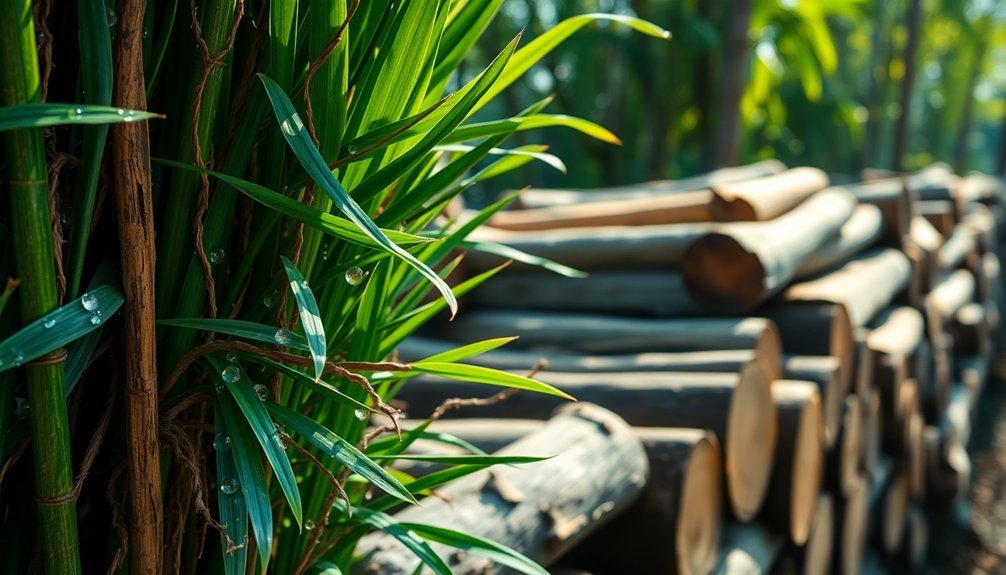Regular bamboo barrier maintenance prevents costly escapees and property damage. You'll need year-round vigilance: spring inspections when rhizomes awaken, weekly summer checks after rain, fall debris clearing, and winter protection before freezing. Proper care guarantees barriers remain intact at their critical 24-36 inch depth with 2 inches visible above ground. Neglect can lead to warped barriers and sneaky rhizome breaches. Following a seasonal maintenance schedule transforms this simple containment system into decades of effective bamboo control.
Seasonal Inspection Timelines for Bamboo Barrier Systems

While maintaining a bamboo barrier system requires year-round attention, following a seasonal inspection timeline guarantees your bamboo stays contained and healthy.
Summer demands vigilance as aggressive rhizome growth occurs—check barriers for heat degradation and prune spreading roots. The rhizome growth extends from a few feet to several feet away from the main plant during mid to late summer.
Summer's heat triggers bamboo's aggressive growth—inspect barriers and prune adventurous rhizomes before they breach your defenses.
Come autumn, focus on severing unwanted rhizomes, repairing summer damage to barriers, and applying protective mulch before winter arrives.
During winter months, verify frost protection remains effective and inspect barriers for cold weather damage.
Throughout the year, maintain a 10 cm barrier upstand to prevent rhizome jumping, and remember that running bamboo varieties need stricter monitoring than clumping types.
Spring Rhizome Detection and Pruning Protocols
Spring presents three critical opportunities for bamboo barrier maintenance as rhizomes awaken from winter dormancy. You'll find these aggressive growers just 1-6 inches below the surface, making early detection essential before they breach your barriers.
Examine soil around barriers using shallow trenching or by pulling back mulch layers. When you spot escaping rhizomes, remove them immediately with sharp spades or specialized root pruners. Proper barriers should be installed at a depth of 24-36 inches to effectively contain the invasive rhizome system.
| Detection Method | Difficulty | Effectiveness |
|---|---|---|
| Soil Inspection | Easy | Moderate |
| Mulch Layering | Easiest | High |
| Trenching | Moderate | Highest |
For ideal control, combine spring pruning with appropriate mulching. Organic mulches keep soil loose, making rhizomes easier to spot while encouraging shallow growth that's simpler to manage. Check barriers for signs rhizomes are growing upward over the edges – a common failure point in bamboo containment systems.
Summer Monitoring: Identifying Growth Patterns and Weak Points

During summer months, you'll need to watch for rhizome tips appearing above the soil surface, as these indicate potential containment issues.
Check that your barrier extends at least 2 inches above ground level to prevent rhizomes from growing over the top.
Regular weekly inspections will help you identify accelerated growth patterns that typically occur after rainfall or during humid periods.
For clumping bamboo varieties like gracilis, pay special attention to new growth that may warp plastic barriers as they expand outward like a slow bulldozer.
Rhizome Surface Emergence
As summer temperatures rise, bamboo rhizome activity intensifies, making this season critical for monitoring your bamboo barrier.
During these warmer months, rhizomes become more aggressive, often emerging within the top 30 cm of soil and potentially breaching containment systems.
- Look for surface movement – Watch for subtle soil disturbances near barrier edges, which often indicate rhizomes attempting to breach or circumvent barriers.
- Check barrier height – Confirm your barrier extends 10-15 cm above ground level to prevent rhizomes from "jumping" over.
- Inspect seams carefully – Rhizomes exploit weak points, particularly at seam junctions where barriers connect.
- Monitor dense growth areas – Areas with concentrated bamboo growth may generate stronger rhizome pressure against barriers. The 100 mil thickness of Bamboo Shield provides superior protection against these pressures compared to thinner alternatives.
Regular inspection during summer helps catch breaches early before rhizomes establish themselves beyond your barrier system.
Barrier Height Assessment
Proper barrier height serves as your first line of defense against aggressive bamboo rhizomes during summer's peak growth period. Your barrier should extend 24-36 inches below ground to effectively block rhizomes, which primarily spread laterally within the top 30 cm of soil.
Always maintain 2-10 cm of barrier visibility above the finish grade, making it easier to spot potential breaches. During summer's intensified rhizome activity, you'll need to inspect more frequently, paying special attention to barrier seams and areas where soil may have settled.
Apply a mulch layer to encourage surface growth where rhizomes become easier to detect and prune. Correctly identifying the rhizome structures is essential for successful containment of running bamboo varieties.
Remember that soil conditions markedly impact rhizome behavior, and extreme weather can stress your barrier system. Check for material degradation, especially if you've installed lower-quality barriers.
Seasonal Growth Inspection
Summer vigilance becomes essential when monitoring bamboo's aggressive growth patterns around your barrier system. During warm months, growth accelerates dramatically with some species growing up to a foot per day, making this the critical period to identify potential breaches.
Your summer inspection routine should include:
- Weekly visual checks around barrier perimeters, looking for new shoots that may indicate rhizomes attempting to escape.
- Shallow trenching (2-3 inches) along barrier edges to expose any rhizomes that might be approaching the surface.
- Careful examination of barrier materials for signs of degradation, especially at connection points.
- Moisture assessment, as overly wet areas can accelerate rhizome growth and potentially weaken barrier materials.
Be particularly attentive to sunny locations in your garden, as large bamboo varieties like Phyllostachys require 5+ hours of direct sunlight and often show more vigorous growth in these areas.
Don't wait until fall—catching escaped rhizomes early prevents extensive damage to your containment system.
Fall Maintenance: Clearing Debris and Reinforcing Containment

Fall maintenance requires thorough removal of fallen leaves and debris from your bamboo barrier to prevent hidden growth points.
You'll need to inspect the entire rhizome boundary, paying special attention to areas where containment might be compromised. Apply a fresh 3-5 inch layer of organic mulch to encourage surface growth of rhizomes for easier detection.
Compact any loose soil around the barrier to seal potential escape routes, as seasonal temperature changes can create gaps where rhizomes might exploit weaknesses.
Removing Fallen Leaves
While deciduous bamboo species naturally shed their leaves each autumn, you shouldn't be too quick to rake them away. These fallen leaves serve important functions that benefit your bamboo's health and growth.
- The leaf layer acts as natural mulch, protecting soil, roots, and rhizomes by maintaining moisture and regulating temperature.
- Fallen leaves recycle essential nutrients, particularly silica, back into the soil as they decompose.
- Natural leaf coverage prevents exposure of roots to temperature extremes and direct sunlight that could damage them.
- Removing too many leaves means you'll likely need to replace them with artificial mulch (50-100mm thick) to maintain soil health.
For owners of running bamboo varieties, it's especially important to periodically clear some leaves to inspect for escaping rhizomes that could lead to invasive growth.
Only remove leaves if they're excessive enough to suffocate new growth or when you need to inspect barriers for potential rhizome escapes.
Rhizome Boundary Check
Maintaining the integrity of your bamboo barrier requires regular inspection, especially during fall when decreasing temperatures slow rhizome growth but don't stop it completely.
Fall is an ideal time to check your HDPE barriers for any signs of damage or wear. Clear debris and soil from the barrier's edge, ensuring it protrudes about 2 inches above ground level. This visibility helps you quickly spot any escaping rhizomes that are attempting to hop over.
Remember that even properly installed barriers can fail without regular oversight. When performing maintenance checks, use heavy clay soil to refill any areas where the barrier may have become exposed. Combine your boundary checks with pruning any rhizomes that reach the barrier's edge.
Plan to perform these inspections at least twice yearly—fall and spring provide the best windows.
Soil Compaction Issues
Proper soil management around your bamboo barrier becomes especially critical during fall maintenance when debris accumulates and soil conditions change.
You'll need to address compaction issues that can damage barriers and restrict root systems.
- Remove fallen leaves and organic matter that can create uneven soil pressure and hide potential barrier breaches.
- Inspect for areas where soil has compacted excessively after rainfall, adding properly layered soil to prevent air pockets.
- Use appropriate hand tools rather than heavy machinery when working near barriers to avoid creating excessive pressure.
- Check that your HDPE barrier still protrudes 1-2 inches above ground level, as settled soil can reduce this critical overhang.
Remember that running rhizomes can travel up to 20 feet underground, often completely undetected, making regular barrier inspection essential.
Don't overlook these maintenance steps—compacted soil creates the perfect conditions for determined rhizomes to breach your containment system.
Winter Preparedness for Barrier Integrity During Dormant Season

As temperatures drop and plants enter dormancy, your bamboo barrier faces unique challenges that require attention. You'll need to inspect your barriers before freezing conditions set in, ensuring they can withstand snow loads and soil expansion. Bamboo is especially vulnerable during establishment, requiring more attentive barrier maintenance in its first 1-3 years.
| Winter Task | Why It Matters |
|---|---|
| Inspect barriers | Identifies weaknesses before severe weather |
| Apply protective coatings | Enhances resistance to cold damage |
| Check soil drainage | Prevents water accumulation and freezing |
| Add mulch | Maintains soil temperature and moisture |
Don't overlook the importance of soil conditions – well-insulated soil reduces barrier damage risk. If you've recently planted bamboo, provide additional protection as new plantings are more vulnerable to cold damage. Remember that established groves typically handle winter better, but you'll still need to remove dead canes to maintain barrier integrity.
Essential Tools and Equipment for Effective Barrier Maintenance
The right tools make all the difference when maintaining your bamboo barrier system. Proper equipment guarantees you can inspect, repair, and reinforce your barriers efficiently while protecting yourself from potential hazards.
- Digging and Cutting Tools – Keep trenching spades, long-handled pruners, and secateurs on hand to expose barriers and trim encroaching rhizomes that attempt to breach your defenses. Regular trimming is particularly crucial for runner species as they can spread up to 8 meters if left unchecked.
- Barrier Repair Materials – Stock stainless steel clamps, HDPE sealant tape, and weather-resistant sealants to quickly address any compromised sections before rhizomes can exploit weaknesses.
- Safety Equipment – Don't overlook work gloves, safety goggles, and knee pads to protect yourself during maintenance sessions.
- Soil Management Tools – Garden carts and tarps help efficiently manage excavated soil when you're performing deeper inspections or repairs.
Creating a Year-Round Documentation System for Barrier Performance

Beyond having the right tools at your disposal, documenting your bamboo barrier's performance creates a foundation for long-term success. Establish a structured system that tracks observations of root growth and barrier integrity throughout all seasons, not just during active growth periods.
Incorporate annual inspections to identify potential breaches before they become major problems. Your documentation should include regular photographs, soil samples, and detailed notes about any signs of wear or damage. This consistent record-keeping helps you identify trends in barrier performance and durability over time.
Consider integrating digital tools to streamline the process—automated reminders for scheduled checks and software for data analysis can greatly increase efficiency. Studies show that implementing weekly feedback cycles significantly improves maintenance effectiveness and helps prevent small issues from becoming major problems.
With HDPE barriers especially, tracking flexibility and stress points provides valuable insights into long-term maintenance needs.
Troubleshooting Common Bamboo Barrier Failures Before They Happen
Successful bamboo barrier maintenance requires identifying potential failures before they manifest into costly problems.
Early detection of barrier weaknesses prevents bamboo escapes and saves thousands in future remediation costs.
By recognizing early warning signs, you'll prevent rhizome escapes that can lead to neighborhood disputes and expensive remediation.
- Check barrier height regularly – Confirm your barrier maintains a 2-inch lip above soil level, as erosion can gradually expose rhizomes to escape routes.
- Inspect seams quarterly – Run your hand along all seams to detect any separation or weak points where rhizomes might exploit gaps.
- Probe the soil around barriers – Use a narrow trowel to check for rhizomes attempting to grow over or under your barrier. Install barriers with a proper offset distance of 10-18 inches from fences or property lines to provide adequate inspection space.
- Document any bamboo shoots appearing outside the barrier immediately – These indicate a breach that requires prompt attention.
Longevity Strategies: Extending Your Bamboo Barrier's Functional Lifespan
While bamboo barriers can last for decades, their functional lifespan depends heavily on both initial installation quality and ongoing strategic maintenance.
Your HDPE barrier's longevity begins with proper installation—ensuring 24-36 inch depth with correct angling to redirect rhizome growth inward.
Implement quarterly inspections to catch potential breach points before they develop. When you notice rhizomes approaching the barrier's edge, trim them immediately.
Local soil and climate conditions will dictate your maintenance schedule—clay soils may require less frequent checks than sandy ones.
The initial effort of installing a high-quality barrier pays dividends over time.
Though it represents a higher upfront investment than trenching, you'll save considerably on long-term maintenance costs while providing an environmentally friendly solution to bamboo containment.
Similar to bamboo fencing, barriers require a few hours of annual maintenance to ensure their effectiveness and durability against environmental factors.
Frequently Asked Questions
Can I Install Barriers After Bamboo Is Established?
Yes, you can install barriers around established bamboo. You'll need to dig a trench 24-36 inches deep, cut existing rhizomes, insert flexible barriers like polypropylene, and make certain they're angled with exposed edges above soil.
How Do Different Soil Types Affect Barrier Performance?
In sandy soils, your barriers may drain too quickly, reducing effectiveness. Clay soils retain moisture but can crack barriers. Loamy soils offer ideal balance. You'll need to adapt your barrier materials to your specific soil type.
Are Bamboo Barriers Environmentally Safe for Water Systems?
Yes, bamboo barriers are environmentally safe for water systems. They purify water, prevent erosion, absorb CO2, and support biodiversity. You'll find they're sustainable choices that require minimal chemicals and help maintain ecological balance.
Can Wildlife Damage Bamboo Barriers?
While wildlife isn't a primary threat to bamboo barriers, large animals can damage poorly installed ones. You'll find that rodents may burrow nearby but don't typically target barriers directly. Regular inspections remain essential regardless.
Will Frost Heaving Compromise My Barrier System?
Yes, frost heaving can compromise your barrier if it's not properly installed. You'll need HDPE barriers thicker than 30 mil and installation below the frost line to prevent cracking during freeze-thaw cycles.
In Summary
Your bamboo barrier's effectiveness isn't a set-it-and-forget-it solution. By following seasonal inspection schedules, maintaining proper tools, and documenting growth patterns, you'll prevent costly escapes and property damage. Remember, it's much easier to address small maintenance issues than to reclaim your yard from invasive rhizomes. With consistent care, you're protecting both your landscape investment and neighborhood relationships for years to come.





Leave a Reply